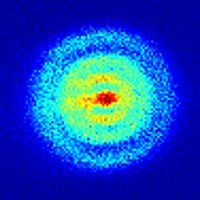How do we know what atoms stuff is made of?
How do we know what atoms stuff is made of?
to be more specific, i was revising over phospholipid (membrane) stuff and i was just wondering how do we know that a membrane is made up of this 'phosphate' head (PO4(3-))and 'fatty acid' tail (C H O).
we can't see atoms can we? so how are we so certain that this is the case? what experiments do they do to find this out?
As a matter of fact, how do we know what atoms anything is made of?
i looked up how we know water is made of h2o and apparently we can split them and use mass spectrometry to find which element it contains and we just guess it. ok... this vaguely makes sense, but then this couldn't work on finding what atom something like the membrane has because the atoms could be arranged in any order so we can't guess it.
Thanks!
to be more specific, i was revising over phospholipid (membrane) stuff and i was just wondering how do we know that a membrane is made up of this 'phosphate' head (PO4(3-))and 'fatty acid' tail (C H O).
we can't see atoms can we? so how are we so certain that this is the case? what experiments do they do to find this out?
As a matter of fact, how do we know what atoms anything is made of?
i looked up how we know water is made of h2o and apparently we can split them and use mass spectrometry to find which element it contains and we just guess it. ok... this vaguely makes sense, but then this couldn't work on finding what atom something like the membrane has because the atoms could be arranged in any order so we can't guess it.
Thanks!
Original post by swopnil
How do we know what atoms stuff is made of?
to be more specific, i was revising over phospholipid (membrane) stuff and i was just wondering how do we know that a membrane is made up of this 'phosphate' head (PO4(3-))and 'fatty acid' tail (C H O).
we can't see atoms can we? so how are we so certain that this is the case? what experiments do they do to find this out?
As a matter of fact, how do we know what atoms anything is made of?
i looked up how we know water is made of h2o and apparently we can split them and use mass spectrometry to find which element it contains and we just guess it. ok... this vaguely makes sense, but then this couldn't work on finding what atom something like the membrane has because the atoms could be arranged in any order so we can't guess it.
Thanks!
to be more specific, i was revising over phospholipid (membrane) stuff and i was just wondering how do we know that a membrane is made up of this 'phosphate' head (PO4(3-))and 'fatty acid' tail (C H O).
we can't see atoms can we? so how are we so certain that this is the case? what experiments do they do to find this out?
As a matter of fact, how do we know what atoms anything is made of?
i looked up how we know water is made of h2o and apparently we can split them and use mass spectrometry to find which element it contains and we just guess it. ok... this vaguely makes sense, but then this couldn't work on finding what atom something like the membrane has because the atoms could be arranged in any order so we can't guess it.
Thanks!
I'm not too sure about individual atoms, but I know that you can use sophisticated techniques such as X-ray crystallography to determine the chemical structure of crystallised molecules such as proteins.
Have a look at this for more information on the above technique: http://en.wikipedia.org/wiki/X-ray_crystallography.
Merry Christmas!
Original post by thegodofgod
I'm not too sure about individual atoms, but I know that you can use sophisticated techniques such as X-ray crystallography to determine the chemical structure of crystallised molecules such as proteins.
Have a look at this for more information on the above technique: http://en.wikipedia.org/wiki/X-ray_crystallography.
Merry Christmas!
Have a look at this for more information on the above technique: http://en.wikipedia.org/wiki/X-ray_crystallography.
Merry Christmas!
AH, i had never heard of such interesting thing called 'crystallography' before, thanks for sharing. isn't science just wonderful?
and yes, merry christmas to you too! and a happy new year soon.
Original post by thegodofgod
I'm not too sure about individual atoms, but I know that you can use sophisticated techniques such as X-ray crystallography to determine the chemical structure of crystallised molecules such as proteins.
Have a look at this for more information on the above technique: http://en.wikipedia.org/wiki/X-ray_crystallography.
Merry Christmas!
Have a look at this for more information on the above technique: http://en.wikipedia.org/wiki/X-ray_crystallography.
Merry Christmas!
actually, do you reckon they use the same technique to work out the atoms?
we can use the x-ray crystallography to work out the electron density of of each atoms and work out the electron density of the molecule and compare which fits.. even though it'd be v hard to tell the difference between close elements.
for example we know hydrogen looks like (Below) so every time we see this sort of thing we know that it's made of a hydrogen atom.

this could then provide one evidence of what atoms something is made of and of course how they are structured.
what do you think? of course its going to be much more complicated yet simpler than this.
I don't know if it helps but Rutherford's gold foil experiment helped us determine the structure of atoms and know exactly how an atom made up (positive charge is centred, not evenly distributed.) but that's more of a sub-atomic thing... as well as gas/bubble chambers which help us see what particles are charged.
Worth looking up if atoms interest you.
Worth looking up if atoms interest you.
Original post by beccatheaviatrix
I don't know if it helps but Rutherford's gold foil experiment helped us determine the structure of atoms and know exactly how an atom made up (positive charge is centred, not evenly distributed.) but that's more of a sub-atomic thing... as well as gas/bubble chambers which help us see what particles are charged.
Worth looking up if atoms interest you.
Worth looking up if atoms interest you.
yes, i am already aware of that. but thanks anyway.
X-Ray crystallography is one technique. I'm not sure specifically how they discovered the structure of membrane phospholipids but other techniques we can use to help determine structures of biological compounds include: mass spectrometry, infrared spectroscopy, NMR spectroscopy, bimolecular flourescence complementation. Less 'direct' techniques such as gel electrophoresis and enzymic titration also may have some value.
I'm not 100% sure on all the chemistry behind these, so it would probably be best if you googled them yourself.
I'm not 100% sure on all the chemistry behind these, so it would probably be best if you googled them yourself.
No individual technique will tell the whole story, Several different techniques must be used to build up a definitive analysis.
Spectrometry will tell you which atoms are present and in what quantity for any given substance but it cannot tell how those atoms are arranged and in what type of structure.
X-ray crystallography will produce a 3D image of the mean position and density of atoms and so build an image of the structure but it cannot tell exactly what atoms are present.
The same for all other techniques mentioned.
All of the techniques are based on physics and the electromagnetic properties of atoms - specifically electrons and em emission.
Spectrometry will tell you which atoms are present and in what quantity for any given substance but it cannot tell how those atoms are arranged and in what type of structure.
X-ray crystallography will produce a 3D image of the mean position and density of atoms and so build an image of the structure but it cannot tell exactly what atoms are present.
The same for all other techniques mentioned.
All of the techniques are based on physics and the electromagnetic properties of atoms - specifically electrons and em emission.
(edited 9 years ago)
Quick Reply
Related discussions
- A level chemistry question help.
- AQA A-Level Chemistry
- Shapes of molecules
- chemistry question
- AQA Chem Unit 1 May 22nd 2015 *OFFICIAL THREAD*
- can i be a Christian and spiritual at the same time?
- Mass Spectrum
- how do you identify permanent dipole- permanent dipole molecules?
- how do u know when to say ions/electrons
- AQA GCSE Chemistry Paper 1 Higher Tier (8462 1H) - 22nd May 2023 [Exam Chat]
- Chemistry help
- Sequences and recurrence relations
- A-Level chemistry
- Chemistry question
- Drift Velocity Q
- Moles in A-Level Chemistry
- Chemistry mass spectrometry .HELP PLS !!!
- Edexcel GCSE Chemistry Paper 1 Higher Tier 1CH0 1H - 27 May 2022 [Exam Chat]
- Atomic Structure - Shapes of S and P orbitals AQA a level chem
- A level Chem mcq
Latest
Trending
Last reply 2 days ago
GCSE Biology Study Group 2023-2024Last reply 4 days ago
A-level Biology Study Group 2023-2024Last reply 1 week ago
Need detailed and specific OCR Biology notes before alevel exam.Last reply 1 week ago
SNAB biology- Access to end-of-topic tests/summaries 2024Last reply 1 week ago
a level biology mitosis questionLast reply 2 weeks ago
Biology surface area to volume rationLast reply 3 weeks ago
aqa biology aslevel calculation question FVCPosted 4 weeks ago
SNAB biology 2024 scientific articleLast reply 4 weeks ago
Resources for edexcel a (snab) a level biology?Last reply 1 month ago
Im losing my mind over this and I don't know where I keep going wrongLast reply 1 month ago
Aqa biology a level paper 3 2023Last reply 2 months ago
AQA A Level Biology Paper 1 2018Last reply 3 months ago
how do you do this please explain stepsLast reply 5 months ago
biology math question ratios alevel aqaLast reply 5 months ago
biology aqa alevel proteins question past paperTrending
Last reply 2 days ago
GCSE Biology Study Group 2023-2024Last reply 4 days ago
A-level Biology Study Group 2023-2024Last reply 1 week ago
Need detailed and specific OCR Biology notes before alevel exam.Last reply 1 week ago
SNAB biology- Access to end-of-topic tests/summaries 2024Last reply 1 week ago
a level biology mitosis questionLast reply 2 weeks ago
Biology surface area to volume rationLast reply 3 weeks ago
aqa biology aslevel calculation question FVCPosted 4 weeks ago
SNAB biology 2024 scientific articleLast reply 4 weeks ago
Resources for edexcel a (snab) a level biology?Last reply 1 month ago
Im losing my mind over this and I don't know where I keep going wrongLast reply 1 month ago
Aqa biology a level paper 3 2023Last reply 2 months ago
AQA A Level Biology Paper 1 2018Last reply 3 months ago
how do you do this please explain stepsLast reply 5 months ago
biology math question ratios alevel aqaLast reply 5 months ago
biology aqa alevel proteins question past paper



